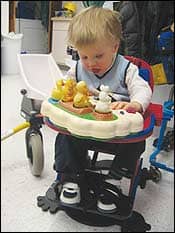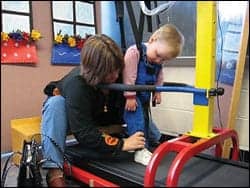When a therapist evaluates a child for mobility equipment, a list of individual needs must be considered to provide maximum comfort and efficiency. Lifestyle, economic, and environmental requirements also must be observed. Once the situation is assessed, the right pediatric mobility devices will enable the child to assume a variety of positions and movements that they would otherwise not attain.
A CASE STUDY
John is a 3-year-old boy who was diagnosed with Joubert syndrome when he was just a few months old. First described in 1968 by Canadian neurologist Marie Joubert, MD, Joubert syndrome is a rare autosomal recessive disorder that is characterized by partial or complete absence of the cerebellar vermis, or connective tissue between the hemispheres of the brain. Features of the syndrome include jerky eye movements, abnormal balance and walking, and mental retardation. Treatment for the syndrome is symptomatic and supportive. Infant stimulation and physical, occupational, and speech therapy may benefit some children. Infants with abnormal breathing patterns should be monitored.
 |
 |
| Three-year-old John is shown in a seated walker/gait trainer (left) and a supported saddle seat (right). | |
Shortly after John’s diagnosis, he began attending the Family, Infant and Child Care Center (FICCC), administered by The Arc of Montgomery County, Rockville, Md. This unique family-centered child care program is specifically designed to meet the medical and developmental needs of children with chronic medical conditions, and features a staff of pediatric registered nurses, specially trained child care providers, and a family worker who provides case management for all participating families.
At 3 months of age, John began physical therapy. His goals were to lift his head in prone and begin to bat at toys. For these activities, we used an early activity system (EAS). John had a hypotonic trunk and was tacitly defensive. A two-piece pediatric trunk support vest was used to give him constant and consistent sensory input and to support his trunk. Beginning at 5 months, he was introduced to supported sitting using the EAS and a specially designed infant posture chair to help with the development of trunk control. By 18 months, John was beginning to roll, but could not sit on his own. During this time, an adjustable activity chair was used for feeding time, and a contoured seat unit, with trunk support, was used to strengthen his muscles for sitting. The contoured seat provided stability and support for John’s pelvis, while enabling him to be responsible for his upper body. In addition, he spent a total of 7.5 hours daily in a stander to help increase overall strength and bone density (as recommended per studies by Brian D. Snyder, MD, on bone density and nonambulatory children).
 |
| An adjustable activity chair supports John’s posture during feeding. |
By the time John was 12 months old, his progress included stepping, with maximal support and manual guidance with a pediatric partial weight-bearing gait device (with a treadmill and harness system). He was assisted to step at .8 mph for 8 minutes three times per week. His day care staff placed him in a supported gait trainer on a daily basis. At 27 months, John began sitting on his own without the trunk support vest.
By this time, he was using a contoured multifunctional seating and mobility system at day care, and a two-in-one activity seat at home, and began moving, backward, on a seated walker/gait trainer. By 30 months, he was able to get in and out of sitting, and by 36 months he could occasionally assume a quadruped position and attempt to creep.
As John improved his stepping skills, he needed a gait trainer that would support his hypotonic trunk but not allow him to hang or sit. From the supported gait trainer, he transitioned to a partial weight-bearing gait trainer/walker. This device uses gas spring cylinders to support a portion, but not all, of the child’s weight. Therefore, if John did not push through his legs and take his weight in standing, he was lowered slowly to within a few inches of the floor. He quickly learned to take his weight in standing and to transition from sit to stand in this device.
ADAPTING TO CHANGE
A healthy baby brother recently joined John’s family, and his mother expressed the desire to take both of her children out in a double jogging stroller. Unfortunately, the soft sling seat design did not supply enough support for John to sit up, and he curled up into a ball. An insertable, lightweight seat and back cushion made all the difference, offering enough trunk support to enable John to sit up, and even move while sitting in the stroller.

|
| The author (left) guides John, who steps with the aid of a harness and treadmill gait system. |
Planning ahead, John will soon outgrow his current car seat and his parents will need to consider obtaining a special needs car seat that will offer the necessary comfort and support for his needs. Fortunately, several models are available, offering adjustable multipositioning seats and head and foot rests, as well as a variety of accessories to customize the unit.
While John is an engaging, fun-loving little boy who continues to gain motor skills, for now, his family does not want a lot of special equipment in the home, so most of John’s “mobility aids” are kept at day care and at school. John’s mother has indicated that she is not yet ready for a wheelchair. Although she and John have taken some lightweight mobility systems with contoured seating, dynamic backs, and adjustable footrests for test drives, she prefers that he continue using his contoured multifunctional seating and mobility system during day care.
For more information on Joubert syndrome, go to www.joubertsyndrome.
John presently uses a ring-style bath support. His mother prefers using the ring over bath chairs, because John sits on the bottom of the tub and has to work a bit on his sitting skills. He can play with his hands and his toys in the water. His mother has also used the bath support ring in the sandbox and kiddy pool, and even as a floor sitter in her living room.
Children like John need lots of support to continue to make progress. This support comes from family, friends, professionals, and equipment. If you have any questions about equipment for your particular client, please send an e-mail to my attention.
Ginny Paleg, MS, PT, is an NDT-certified pediatric physical therapist and a University of Maryland doctoral candidate, Silver Spring, Md. She is the APTA representative for pediatric section reimbursement, a Listserv monitor, and CEU instructor. Paleg also serves on the editorial advisory board of Rehab Management. She can be reached at .
Recognizing Joubert Syndrome
First described in 1968 by Canadian neurologist Marie Joubert, MD, Joubert syndrome is a rare, genetic disorder affecting the area of the brain that controls balance and coordination. It is characterized by absence or underdevelopment of the cerebellar vermis (or connective tissue of the two hemispheres of the brain) and a malformed brain stem.
Among the characteristics of the syndrome are irregular breathing patterns, which are usually noticeable at birth. For example, John’s breathing alternates between deep rapid breathing (almost like panting) and periods of severe apnea. The rate of respiration may increase more than three times that of normal breathing (up to 200 breaths per minute), and the apnea may last up to 90 seconds. In John’s case, rapid breathing occurs most often when he is awake, especially when he is aroused or excited. Apnea can occur whether John is awake or asleep. Since such abnormal breathing can cause sudden death or coma, infants with Joubert syndrome require close supervision. For unknown reasons, the breathing tends to improve with age—usually within the first year of life.
The central nervous system problem affects the larger muscles of the body, including the arms and legs. Infants with Joubert syndrome reach developmental milestones, such as sitting or walking, much later than normal. For example, some may learn to sit without support around 19 to 20 months of age (normal is 6 to 8 months). Most children are not able to take their first steps until age 4 or older. Their balance and coordination are also affected, which makes walking difficult. Many have an unsteady gait and find it difficult to climb stairs or run, even as they get older. Approximately 75% of children learn to sit and 50% learn to walk. Assistance is usually required to complete kneeling to stand transition. Extreme calcaneal eversion is noted when standing. Gait is unstable and tandem walking is poor.
Cognitive delays are also a part of the syndrome, although this can vary. Most individuals with Joubert syndrome have fairly significant learning impairment. Some individuals have little or no speech. Others are able to learn words, and can talk with the aid of speech therapy. They do tend to have pleasant and sociable personalities, but problems in behavior can occur. These problems often emerge in temperament, hyperactivity, and aggressiveness.
Careful examination of the face, especially in infancy, shows a characteristic appearance. These children tend to have large heads, prominent foreheads, high and rounded eyebrows, and droopy upper eyelids, or ptosis. The mouth remains open, and looks oval shaped in appearance. The tongue may protrude out of the mouth, and rest on the lower lip. The tongue may also quiver slightly. Occasionally, the ears look low-set on the face.
Less common features of the syndrome include minor birth defects of the hands and feet. Some individuals with Joubert syndrome are born with polydactyly (with extra fingers on each hand). The finger may or may not include bone, and could just be a skin tag. A few of these individuals also have extra toes on their feet.
A number of individuals with Joubert syndrome have died in the first 3 years of life. Some continue to have apnea, and require medical care throughout their life. Although the true life span of these individuals remains unknown, there are some Joubert syndrome patients who are in their 30s.
Treatment for Joubert syndrome is symptomatic and supportive. Infant stimulation and physical, occupational, and speech therapy may benefit some children. Infants with abnormal breathing patterns should be monitored.
—Ginny Paleg, MS, PT





